- Submissions

Full Text
Trends in Textile Engineering & Fashion Technology
Indian Traditional Textiles an Overview on the State of Madhya Pradesh, India
VR Sampath* and Kavita Kadam
Shri Vaishnav Vidypeeth Vishwavidylaya, Indore, India
*Corresponding author:VR Sampath, Shri Vaishnav Vidypeeth Vishwavidylaya, Indore (Madhya Pradesh) 452011, India
Submission: July 06, 2023; Published: August 22, 2023

ISSN 2578-0271 Volume9 Issue1
Abstract
Madhya Pradesh is famous for the exclusive Hand loom and power loom production of Chanderi sari, Maheshwari sari and Tassar sari. These are the world-famous brands of India as well as abroad. In these weaving different types of saris, dupatta, Towel, Handkerchief, Kurta-Salwar cloth, and Dhotis are introduced. The complicated designs like Brocade, Kalamkari, Piping, Jal Pallu, Bandhani and Colour weave effects are the most popular brands of this class of products. The present paper gives an overview of various traditional textiles at Madhya Pradesh.
Keywords:Chanderi sari; Tassar sari; Traditional textiles; printing styles
Introduction
Apart from weaving in different designs many of the printing styles are also used for enhancing the aesthetic and appealing values of these materials. In this manner various printing designs are also incorporated for making appealing, look to these kinds of products. Many of the printing styles like resist, direct, discharge is famous for many times. In addition to that traditional printer, master printers they also do not easily convinced about to use the modern and scientific method. Because of lack of knowledge of modern tools to operation, lack of computer skills, proper adjustments of mixing the chemicals, dyes and pigments, they use only their orthodox kind of experience and techniques to print.so resulting, limited invention of shades, more time consumption and bleeding of colour takes place. Even fastness properties like washing, Rubbing and light cannot be improved. Even obtained colour shades get non-appealing, dull, patchy and uneven. Therefore, many of the decade’s viewers and costumers, even in international and national levels of expo similar types of colour and the print effects have always seen. It is always made complaints by the handloom cloth purchasers also that - “Which clothes are printed by the Bagh, Dabhu and Dagga printing. These products always found to bleed the colour”. And out of them Nandana printing has been extinct due to lack of knowledge and non-scientific uses [1].
Maheshwari weaving
The Maheshwari art of weaving originated its name from the town of Maheshwar on the banks of river Narmada, where the queen Rani Ahilyabai Holkar of Indore settled a number of weavers from Surat and Maharashtra to weave Saris and Turbans for the royal household. With fine cotton yarns in its weft and silk in the warp, this fabric is light and airy for the summers, yet has the subtle luster of silk. The detailing on the walls of the Fort of Maheshwar inspires the designs of the Maheshwari saris. The unique feature of a Maheshwari sari is its reversible border. The border is designed in such a way that both sides of the sari can be worn. This is locally known as ‘Bugdi’. The golden thread is used to weave exotic motifs and designs on the ‘kinar’ (border) and the ‘anchal’ (pallu) of the sari. Traditional motifs such as Guldasta, Aambuta, Ghungroo, Chatai kinar, Hansa, Mayur Buti, and Chandtara are very popular. These exotic hand-woven products are an epitome of the rich heritage that has passed on through generations. Apart from the traditional saris and dupatta, Maheshwari weavers are now experimenting with contemporary products like stoles, scarfs, table covers and yardages which can be customized (Figure 1).
Figure 1:Maheshwari weaving.
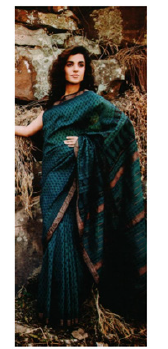
Chanderi sarees
This traditional sari originated from the small town of Chanderi, situated on the boundary of two cultural regions of the state, Malwa, and Bundelkhand. The cloth woven in Chanderi is the favorable choice of Queens in India. The fame of Chanderi cotton competed with that of the fine Dhaka muslin of 300s count till the 17th century. This fine yarn was strengthened using the extract of a locally available root “Kolikanda’, Till the nineteen forties, Chanderi saris had a natural off-white body, as the predyed yarn was not used. Later, the cotton weft began to be dyed resulting in the wellknown Chanderi pastels (Figure 2).
Figure 2:Chanderi.
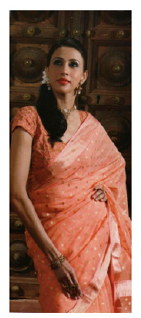
The Chanderi artisans used silk as warp and cotton as weft. Generally, these saris have a rich gold border and two gold bands on the ‘palla’. The yarn used in Chanderi fabric is of high quality and is extra fine, which leads to an astounding product with a magical translucency. Chanderi is also identified with the piping kinara zari border woven along the selvage using mostly silk-based zari. Another feature exclusive to Chanderi saris is its sheer texture containing ‘zari bootis’ in various shapes and sizes. The fame and romance of the soft Chanderi lay in their constant reference to nature-fruits, flowers, leaves and birds [2].
'Tussar silk weaving
Tussar Silk is also known by its Sanskrit name Kosa Silk, is produced through Tussar silkworms (Antheraea Mylitta and Antheraea Proylei). Tussar production in Madhya Pradesh is being done in places like Saunsar, Balaghat and Hoshangabad districts. Tussar silk is valued for its rich texture and natural deep gold colour. It is extracted from cocoons that are fed on wild trees. It is available naturally in shades of gold-pale, dark, honey & cream, tawny etc. Apart from its natural colour, Tussar yarn is often dyed in desired colours & is handwoven to obtain Tussar Silk saris, yardages etc. Tussar silk is most suitable for wearing on special occasions like marriages, worships and other religious functions etc. It flaunts in every Indian woman’s wardrobe and the fine work of art done on it makes the wearer shine, every time they exhibit it. Right from evening wear to saris, this fabric has given the world a vast taste of designs and apparels (Figure 3).
Figure 3:Tussar silk.
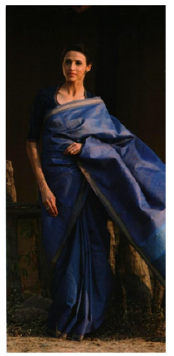
Bagh print
Bagh derives its name from the native river ‘Baghini’. The block printers of Bagh drew inspiration from the river and its surroundings to evolve these prints while keeping their original techniques intact. Bagh printing is a painstakingly tedious process; a single piece of cloth undergoes various transformations over 25-30 days before it finally gets ready for use. First, the fabric is prepared for printing by soaking it in raw sea salt, non-refined castor oil, goat dung and dried three times in succession. After the final drying, it is dipped into a solution of Harada powder [3]. The red color for printing is made using seeds of Tamarind mixed with Phitkari (Alum). The black colour is prepared using Iron Filings and Gud (Jaggery) which is left for 15-20 days. Printing is done with carved wooden blocks on cloth spread on addas (tables). Each block has a name: chameli (jasmine), maithir (mushroom), leheriya (waves), keri (mango), and jurvaria (small dots). The cloth is dried for 15 days, then washed in flowing river water and finally boiled in water mixed with Dhavadi flowers and Aliizarin (root of Aal tree) in a Copper vessel (Figure 4).
Figure 4:Bagh Print.

Nandna fabric
Nandna is a mud resist block-printing craft of Madhya Pradesh and is one of the very few crafts being practiced in its original form. Nandana block print is practiced in Tarapur village of Neemuch district. The fabric thus printed is then worn by the women from the local Bhil tribes as their traditional attire. But what sets Nandna prints apart from the other printed fabrics is their intact rustic look and ancient motifs, equally revered by their contemporaries [4].
In Nandana hand block printing process fabric is first printed with begar (Alum) and then dyed with alizarin to get a red design pattern. After this fabric gets printed with Dabu resist with “resin” paste, in local chhippa community it is called “Daamar”. (Coal-tar in English) covering red designs and dipped into an indigo dye tank to get deep indigo blue background. Traditionally resin paste is used as a better resist so that fabric gets dipped into an indigo tank a minimum 5-6 times till it gets deep blue. “Resin” was boiled for 24 hours then it is printed on the fabric while boiling. There are 4 motifs that are used in the printing of Nandana namely Champakali, Amba (mango), Chilli and Jalam Buta (creeper web) and it is majorly worked upon a base of Indigo. So, if you happen to visit Mrignayanee then don’t forget to buy this beautiful art for yourself (Figure 5).
Figure 5:Nandna Fabric.
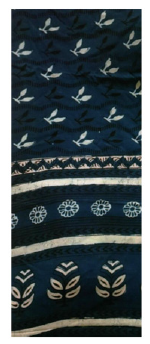
Batik print
Batik is an ancient art, which uses wax and dyes to create a visual art on fabrics. It is believed that the term batik is a derivation from the word ‘Ambatik’ which when translated literally stands for a piece of cloth with small dots or writing with wax or drawing in broken lines. Batik is known to have existed in China, Japan, India, Indonesia, Thailand, Europe, and Africa. In Madhya Pradesh, Batik craft is widely practised on the banks of the holy river Shipra (Figure 6).
Figure 6:Batik Print.
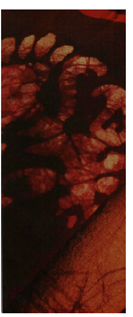
Artisans make free-hand designs by placing dots and lines using a pen-like tool on fabric filled with wax as a resist and then dyeing the fabric in vibrant colours. This technique of fabric decoration has been adapted in India using a coconut hair pen to apply wax and is also done using wooden/metal blocks for quicker production [5]. On dyeing, the applied wax cracks up on the fabric surface allowing dyes to seep in. The wax is finally removed from the fabric by boiling in hot water. The result of this elaborate process is an interesting fabric-surface with a mesh of crackled dye. Since most work is free hand, the product is exclusive and one of a kind. A vast range of beautiful products like bed sheets, stoles, drapes is produced using this technique.
Dabu print
Dabu print is an ancient mud-resist hand block printing technique, which acquired its name from the local deity of the printer’s community ‘Nandev’. The craft evolved specifically to drape the tribes of Jhabua region with beautifully printed ‘odhnis’, ‘ghagras’ and turbans. The only four motifs of Nandna are- ‘jaalam buta’, ‘amba buta’, ‘champ kali’ and ‘mirchi’ in colors like mudbrown, red, blue and green [6].
For this craft, the craftspeople use a meticulously prepared mud mixture to make impressions on cloth using wooden blocks. The motifs and dyes are representative of the artisan’s deep respect for nature and are derived from flowers and other flora known to the local artisans.
After the application of mud-resist onto the fabric, it is dyed in desired colors. The process may be repeated for double or triple dabu effects. After every dyeing, the fabric is thoroughly washed so as to remove the mud application. Finally, the non-dyed part where the resist has been applied is revealed after washing. Some of the colors penetrate onto the fabric caused by mud cracking. The result is exquisite and exhilaration refreshing, this handcrafted process is one that has stirred the creative and aesthetic minds of both the artists of Dabu and the connoisseurs of this fabric across the country. A wide variety of its products are already available all year round, still, we offer the facility to get them in on-demand designs (Figure 7).
Figure 7:Dabu print.
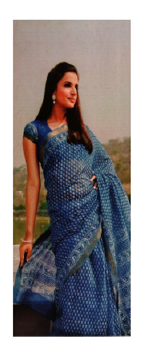
Zari zardozi
The word ‘Zardozi’ can be broken up into to two words- ‘Zar’ meaning ‘gold’ and ‘Dozi’ meaning ‘embroidery’, in Persian. Thus, the word Zardozi’ actually means ‘embroidery in gold’. During the Mughal Period, the ancient Zardozi rose into prominence due to the large-scale royal patronage it received. ‘Zardozi’ is painstaking work where the cloth is stretched out on an ‘adda’ (frame). The artisans sit around it on the floor and do embroidery work on the cloth [7]. The ‘Zari’ or ‘Kalabattu’ is done using Zari and other materials such as ‘poyj’ (beads in pearl and glass finish), ‘Giaha’ and ‘Kora’ (springlike metal), ‘Sitara’ (Sequins of various type), and ‘Kutdana’ (Glass Pipe) etc The Zari Zarodzi work is done over a large number of clothing items and the products can also be tailor-made to suit the particular demands of clients (Figure 8).
Figure 8:Zari Zardosi.
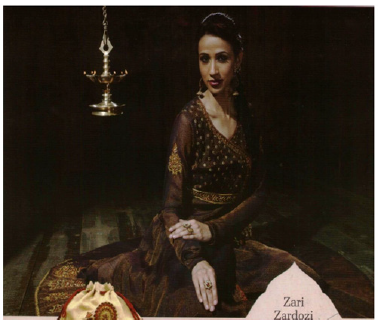
Handwoven cotton bedsheets
Figure 9:Handloom Cotton Badsheets.

The soft, elegant and minimalist bedspreads are the creation of the master craftsperson, who are predominantly women, from Padana & Sarangpur, small villages in Madhya Pradesh. Natural cotton thread of 2/40s, 2/20s, 20s count is used for weaving these user-friendly products. An arduous process on fly shuttle traditional today usage. The bedspreads are loom-stage finished fabrics, which are ornamented with checks, and stripes available in a plethora of colours and designs. These bedspreads are easy to maintain and are economical (Figure 9).
Punja durrie
To ensure that the threads are firmly positioned in the matrix of weaving, the craftsmen deliberately press them using a comblike instrument called punja, which renders the woven fabric strong while introducing new rows of knots. Patti is another tool that is used to beat the carpet so that all the knots and threads settle down. Other locally invented apparatus such as dhoori is used to cut off the excess thread after weaving. However, now there is a mechanical facility to do the same by cutting all the threads to a uniform size [8].
Sidhi is home to traditional punja dari and carpet weavers. With very beautiful designs, vibrant colours, rich textiles and high durability of more than 50 years, the punja durries and carpets of Sidhi are the hallmarks of quality and beauty. There are around 40 punja dari and carpet weaving units working in clusters in Sihawal block of Sidhi. The durries and carpets have attained fame through handicraft fairs at international and national levels. The durries have also been selected under the “One District One Product” scheme for its promotion and market linkage (Figure 10).
Figure 10:Puja Durrie.

Gwalior carpet
Since the Mughal times, Gwalior in Madhya Pradesh has carved a niche for itself in the weaving of carpets. The British also used to purchase carpets from Gwalior. Later on, weaving also began in Shahdol & Mandla belt. The Madhya Pradesh Hastshilp Vikas Nigam has initiated woolen carpet weaving in Gwalior, Guna, Rajgarh, Sidhi, Satna, Shahdol, Jabalpur, Mandla, Chhindwara, Sarguja and Ramgarh. The carpet weavers of Madhya Pradesh are undisputed masters of not only the art of weaving but dyeing also. The colouring was earlier done by means of natural dyes, but presently it is being done with synthetic dyes as well. The pattern is an integral part of knotted carpets and traditional patterns have continued with varying combinations. Woolen carpets are available in vibrant colors with both floral and geometric designs. The weavers have used their ingenuity to transform traditional motifs into modern designs; drawing from the treasury of ancestral motifs: trees and flowers in carefully blended colours. These masterly renditions are a vibrant luxury for the floors of your working and living space. The hand knotted wollen carpets of medium fine qualities (10’x12’, 12’x12’, 9”x16”, and 10’x18’) are available (Figure 11).
Figure 11:Gwalior carpet.
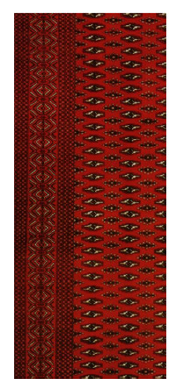
References
- Indian Textiles by John Gillow and Nicholas Barnard
- Traditional Textile by John Gillow and Nicholas Barnard
- Noopur S (2018) Textiles of India.
- Artistic Heritage in Indian Textiles (2008)
- Rana V (2019) 10 Fabrics that are a Reflection of Indian Heritage.
- https://www.utsavpedia.com/motifs-embroideries/kalamkari-art/
- Textiles of Madhya Pradesh, Indian Culture
- Textiles and Fabrics of Indian States, Indian Culture
© 2023 VR Sampath. This is an open access article distributed under the terms of the Creative Commons Attribution License , which permits unrestricted use, distribution, and build upon your work non-commercially.
 a Creative Commons Attribution 4.0 International License. Based on a work at www.crimsonpublishers.com.
Best viewed in
a Creative Commons Attribution 4.0 International License. Based on a work at www.crimsonpublishers.com.
Best viewed in 







.jpg)






























 Editorial Board Registrations
Editorial Board Registrations Submit your Article
Submit your Article Refer a Friend
Refer a Friend Advertise With Us
Advertise With Us
.jpg)






.jpg)














.bmp)
.jpg)
.png)
.jpg)










.jpg)






.png)

.png)



.png)






